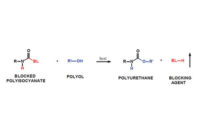Q&A About Polyurethanes: Coatings Raw Materials
Can you provide some general information regarding coatings raw materials?

Polyurethanes have been used to make high-quality coatings for over 50 years, and are the preferred polymer for a range of demanding applications. They are formulated with both aliphatic and aromatic isocyanates, along with a variety of hydroxyl functional polyols. The polyols typically make up the majority of the overall coating formulation. The polyol is often the deciding factor in film properties such as modulus, glass-transition temperature and elasticity.
Performance and cost considerations determine the raw materials used for a specific application. The coatings can be solventborne, waterborne or 100% solids, depending on the processing requirements. Due to the breadth of this topic, comments will be limited to the most significant commercial polyisocyanates.
Products are available that are based on toluene diisocyanate (TDI), hexamethylene diisocyanate (HDI) and isophorone diisocyanate (IPDI). These monomeric diisocyanates are not used directly to prepare coatings, but are first converted into polyisocyanates. This increases the molecular weight and functionality of the final isocyanate. They are monomer stripped to address product safety issues and facilitate processing in an industrial environment.
The TDI-based crosslinkers can be used in a two-component system to react with a polyol or can be applied to a substrate and allowed to cure with ambient moisture. They offer the advantage of curing faster than aliphatic based isocyanates, but will discolor over time. Trimer and urethane-modified products are available and are supplied in solvents such as ethyl and butyl acetate. Mixed trimers based on HDI and TDI are available if a higher level of light stability is required. These products should be especially examined for cost-sensitive applications.
The light stability, gloss retention, and high weatherability of HDI and IPD-based polyisocyanates make them ideal for the most demanding applications. Trimer-, biuret- and dimer-modified HDIs are commercially produced. They differ in viscosity and functionality. Each of these products is an oligomer mixture rather that a “pure” trimer or biuret. They may be supplied in solvent form; they have also been designed to be used in two-component 100% solids applications.
Biuret-modified polyisocyanates have been commercial for many years, and are available in solvents and at 100% solids. HDI biurets are offered in high- and low-viscosity versions. For lower-VOC coatings applications, trimers based on HDI polyisocyanates are often recommended. HDI trimers are also available in low- and high-viscosity versions. Low polyisocyanate viscosity is typically a result of a lower overall functionality. Very low viscosity polyisocyanates based on a dimer structure are used as a blending component to reduce viscosity. High- and low-functionality polyisocyanates are combined to optimize end use performance and application characteristics. To achieve faster dry times and higher hardness, trimers of IPDI are often blended with HDI polyisocyanates. The two-component formulation will also have a tendency for a short pot life.
Whether you are new to polyurethane chemistry applications or are an experience formulator, I would suggest that you examine a recent review published in Angewandte Chemie’s International edition (2013-52/36). It provides information about polyurethane raw materials and applications ranging from polyurethane foams to elastomers and coatings and adhesives.
Any views or opinions expressed in this column are those of the author and do not represent those of ASI, its staff, Editorial Advisory Board or BNP Media.
Looking for a reprint of this article?
From high-res PDFs to custom plaques, order your copy today!







